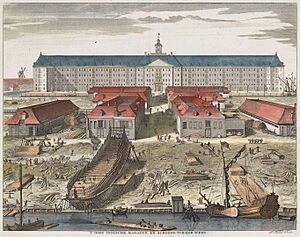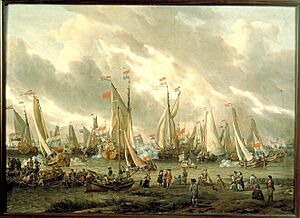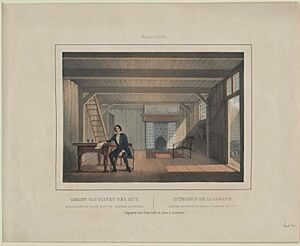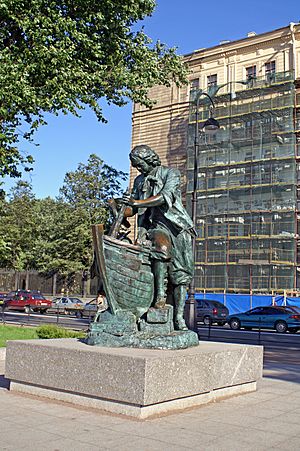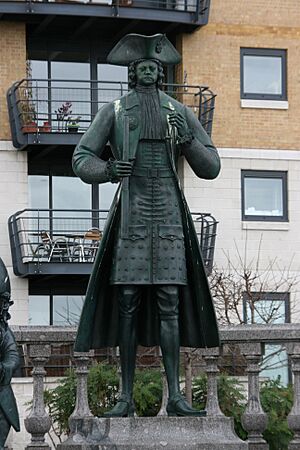Grand Embassy of Peter the Great facts for kids
The Grand Embassy (Russian: Вели́кое посо́льство, romanized: Velíkoye posól'stvo) was a special trip made by Peter the Great and his team to Western Europe. It happened from March 9, 1697, to August 25, 1698. This journey was a big diplomatic mission for Russia.
Contents
Why Peter the Great Traveled to Europe
In 1697 and 1698, Peter the Great went on his Grand Embassy. The main reason for this trip was to make the Holy League stronger. This was an alliance between Russia and several European countries. Their goal was to fight against the Ottoman Empire and help Russia gain control of the northern coast of the Black Sea.
Peter also wanted to hire skilled people from other countries to work for Russia. He was especially interested in getting new military weapons and learning how to make them.
Officially, three "grand ambassadors" led the Grand Embassy: Franz Lefort, Fedor Golovin, and Prokopy Voznitsyn. But Peter himself was secretly in charge. He traveled secretly under the name of Peter Mikhailov. This was hard to do because Peter was very tall, about 6 feet 8 inches!
Peter met with Friedrich Casimir Kettler, the Duke of Courland. He also made an alliance with King Frederick I of Prussia. In mid-August 1697, he arrived in the Dutch Republic. There, he worked secretly as a shipbuilder starting from September 1.
Learning in the Netherlands
On September 1, Peter watched a pretend naval battle. He liked it so much that he asked for it to be repeated weeks later. While visiting Amsterdam, he learned how to draw ships and make etchings from Adam Silo and Ludolf Bakhuysen. These artists were famous for painting seascapes.
Peter also met Frederik Ruysch, who taught him about anatomy. He learned how to do dissections and even pull teeth! He also met Jan van der Heyden, who invented the fire hose. Peter visited Jacob de Wilde, who had a famous collection of gems and coins. Jacob's daughter, Maria de Wilde, made an engraving of Peter meeting her father. This picture shows the start of Western European art styles in Russia.
The Great Embassy visited the States General of the Netherlands to ask for help against the Ottoman Empire. This was for the Second Russo-Turkish War. When Peter did not get the support he wanted, he left the meeting. He even pulled his wig over his head, surprising everyone.
On September 11 or November 9, 1697, Peter met with William III. William ruled both the Netherlands and England. This meeting was a big deal, and a special medal was made to remember it. Peter wanted an alliance and was ready to help William in the Nine Years' War against France.
The Grand Embassy did not manage to make the anti-Ottoman alliance bigger. Instead, they focused on getting different equipment and hiring foreign experts. These experts were especially important for military and naval matters. In October 1697, Antonie van Leeuwenhoek, a famous scientist, visited Peter on his boat. He gave Peter a special "eel-viewer" so Peter could study blood circulation whenever he wanted.
William invited Peter to visit England in 1698. Peter left for England on January 18, 1698, and stayed there for 105 days.
Peter's Visit to England
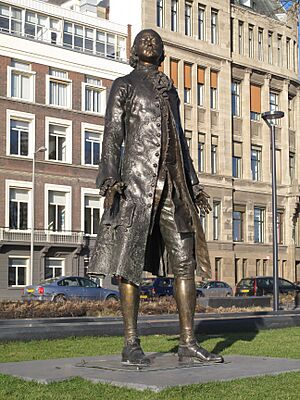
Peter and some of his group arrived in England on January 11, 1698 (Old Style calendar). They left on April 21. Peter's group included many people: four chamberlains, three interpreters, two clockmakers, a cook, a priest, six trumpeters, 70 soldiers, four dwarves, and a monkey! They landed at Watergate to York House.
Peter often met with King William and his court in an informal way. This was how he liked to travel through Europe. By February, the English king wanted to know when Peter would leave. The king had tried cutting the Russians' daily money and refusing their requests for horses and carriages, but it didn't work. Peter finally chose a departure date in late April.
King William asked Peregrine Osborne, who was the Marquess of Carmarthen, to design a yacht for Peter. It was named the Royal Transport.
What Peter Learned in England
Peter visited many important places in England. He went to the Royal Observatory, where he learned about navigation. He also visited the Royal Mint, the Royal Society, and the University of Oxford. He saw several shipyards and artillery factories.
He studied how English cities were built. He later used this knowledge to help build Saint Petersburg. At Deptford's royal dockyards, he learned skills that helped him create a Russian fleet. At Woolwich Arsenal, he learned how to make artillery. Even though he had chances to meet famous people like Isaac Newton, Christopher Wren, and Edmund Halley, he did not.
Peter focused on getting valuable technology. He found that the Dutch shipyards, while advanced, did not write down their methods. Peter said they used "intuition and unwritten custom." He decided to visit Britain because he heard British shipyards used "art and science" practices that could be learned quickly.
Meeting the Quakers
At first, Peter did not want to meet the Quakers. But he eventually became interested. Five Quaker leaders, including Thomas Story and William Penn, met with him. The Quakers gave Peter some of their books.
Peter asked them how their faith could help a country if their followers would not join the army. The Quakers explained that their faith taught hard work, honesty, and new ideas. Peter was impressed. He even went to a Quaker meeting the next Sunday without telling anyone.
William Penn and Peter spoke in German, a language they both knew well. The house where Peter stayed had been a refuge for William Penn years before. Penn was one of the biggest non-royal landowners in the world at that time. They met twice. After their meetings, Penn wrote a letter to Peter. He reminded the Russian ruler that to rule well, he must rule for God.
Benefits for England
Peter's visit was not just good for Russia; England also gained from it. Peter's father, Tsar Alexis, had stopped diplomatic and trade relations with England after King Charles I was executed in 1649. Trade between the two countries had dropped a lot.
By Peter's time, many English merchants wanted to trade with Russia. They knew they could sell many goods there. English shipbuilders also wanted to import Russian raw materials, especially oak wood, for the Royal Navy. The English were somewhat successful in getting Peter to agree to stronger trade ties.
Historian Arthur MacGregor wrote that for 20 years after Peter's visit, British influence in Russia was very strong. It showed in social customs, crafts, ships, and naval organization. This influence reached many people through the Moscow School of Mathematics and Navigation.
Damage at Sayes Court
Peter first stayed at 21 Norfolk Street in London. On February 9, he and his group moved to Sayes Court, a house next to the Deptford Dockyard. They rented it from John Benbow, who was renting it from John Evelyn. John Evelyn did not meet Peter.
The Russian group caused a lot of damage to the house and gardens. Sir Christopher Wren, the royal surveyor, calculated the cost. It was £305 9s 6d, which included £3 for "wheelbarrows broke by the Czar." The damage was so bad that:
- No part of the house was safe.
- All floors were covered in grease and ink, and three new floors were needed.
- The tiled stoves, door locks, and all paintwork had to be replaced.
- Curtains, quilts, and bed linen were "tore in pieces."
- All the chairs, over 50 of them, were broken or gone, probably used for fires.
- Three hundred window panes were broken.
- "Twenty fine pictures" were torn, and their frames were broken.
- The garden, which Evelyn was very proud of, was ruined.
On April 21, 1698, Peter left England for Holland. His yacht, the Royal Transport, went with him for part of the journey. It was then set to sail to Russia without him. Reports vary, but Peter managed to hire between 60 and 500 British people to work for the Russian state. Many of the most important ones were on the yacht that took them to Arkhangelsk.
Return to Russia
On his way back to Russia, the Grand Embassy had meetings in Vienna. They talked with Russia's old allies in the Holy League, like Austria and Venice. They tried to stop Austria from making a separate peace treaty with Turkey. Peter had planned to visit Venice, but he canceled it. He heard about the Streltsy Uprising in Moscow and quickly returned to Russia.
The Grand Embassy did not achieve its main goal of strengthening the anti-Ottoman alliance. However, it gathered important information about the world situation. Peter learned that it would be impossible to make the anti-Turkish group stronger because the War of the Spanish Succession was about to start. The trip also gave him ideas for gaining access to the Baltic Sea.
On his way back to Russia, Peter the Great met with Augustus II of Poland-Lithuania in Rava-Ruska. They had talks that later led to Russia and Poland becoming allies against Sweden in the Great Northern War.
See also
- Czar Peter House







